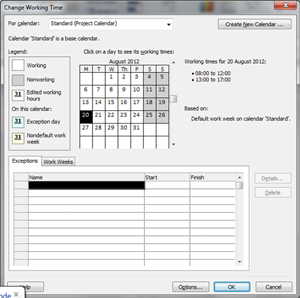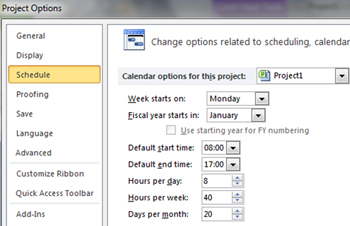Want to know how to change the default calendar in Microsoft Project to reflect your actual working project hours? This tutorial from our MS Project trainer Maggie will give you a glimpse of the sort of content you'll learn on our beginners Microsoft Project courses. We also run PRINCE2 courses and an Introduction to Project Management workshop so you can gain the skills to stop your projects from running overtime.

The Default Calendar in Microsoft Project is set to an 8 hour day, the Start time being 8:00 am and the finish 5:00 pm, with an hour for lunch. This calendar is called the Standard Calendar and is the calendar initially used for all Projects. This calendar can be found from the Project Menu, Change Working Time.

This calendar can be modified to reflect the working hours for an entire project. You can modify the working hours to the actual working hours for your Company, so if your standard Company hours are 9:00 am to 17:30 pm with an hour for lunch you can change the calendar to these times. With this calendar you are setting the Work Hours for your people
However, there is also a calendar that is used when you enter your tasks, this can be found in the File Menu, Tools and Schedule tab. You can set in here the start and finish times for the tasks, hours per day and hours per week. It is important that you change the calendar before entering any tasks. If the calendar is changed afterwards, the duration of the tasks will change to reflect the new hours, thus changing what you have already set.

If you are changing times for the tasks, it is important to change the resource calendar to the same time, otherwise when you assign your resources the durations of your tasks will change. Follow the instructions below to see how to do this.
Guest Author
31 Aug 2012
 Microsoft Project is the definitive tool for project managers. However using it in a shared environment can often lead to difficulties - particularly when you've
Microsoft Project is the definitive tool for project managers. However using it in a shared environment can often lead to difficulties - particularly when you've
lead to difficulties - particularly when you've got lots of projects thatuse the same resources.This is where resource pools can be invaluable - and they're not that hard to set up!
To learn more about Resource Pools, and plenty more besides in MS Project, why not attend one of our public 2-day MS Project Training courses here in Brighton, Sussex? For general project management skills we also run a 1-day Introduction to Project Management training course, and we are also an Accredited Training Organisation for PRINCE2 Training.
How to use Resource Pools in Microsoft Project 2010
Creating the same set of resources in each project is unnecessary duplication. You can create a resource pool, entering the resources only once and saving time and storage space. The resources reside in one file and other projects can link into this pool, thus creating project sharer files. If information is changed in the pool, all sharer files will be updated. Also when the pool is changed from a sharer file, the resource pool is updated.
Creating a Resource Pool in MS Project 2010
Follow the following simple steps to create a resource pool in Project 2010
- Create a New Project
Don't worry about the start/end date, or entering any tasks
Andy Trainer
9 Feb 2011
Microsoft Project 2010 was released last year and many of our clients are upgrading to the new version. Our guest blogger this week is one of our MS Office trainers and she has put together a list of some of the bugs in Project 2010 and (most importantly!) ways of getting around them. In time these bugs will be ironed out with updates but for the time being they can be extremely frustrating if you encounter them.
To learn more about the Office Suite of products, see our Microsoft Office training courses, including MS Project training, Beginners Excel training and Advanced Excel training. If you are upgrading from a previous version, our Office 2010 Upgrade training course covers all the new features in Office 2010.
Bugs in Microsoft Project 2010
As a Microsoft Project trainer I was interested to see the new Project 2010 and how it compares to previous versions. I am always keen to find out what’s new with an application and what benefits it can bring to the users that I train, and how best to communicate these features. There are some great new features such as:
- The Team Planner - this enables you to click and drag work from one resource to another.
- The ability to use the drop down list in the Resource Names column in the Gantt Chart table to select more than one resource.
- An icon in the Indicators column in the Gantt chart table to indicate over-allocations. This saves you having to go a view such as the Resource Sheet to check for over-allocations.
- The ribbon interface which matches the other MS Office applications.
Whilst working with Project 2010, various bugs came to light and a quick “google” and a chat with some other Project trainers reassured me that it isn’t something that I am doing wrong and that I am not the only one to have discovered these problems. For the most part, these bugs affect the display only and if you dig deeper into the detail in other views, the data in the background is correct.
Look out for the release of the Service Pack, but in the meantime, here is a description of the bugs that I have discovered and my suggestions of how to get around them:
Andy Trainer
25 May 2011